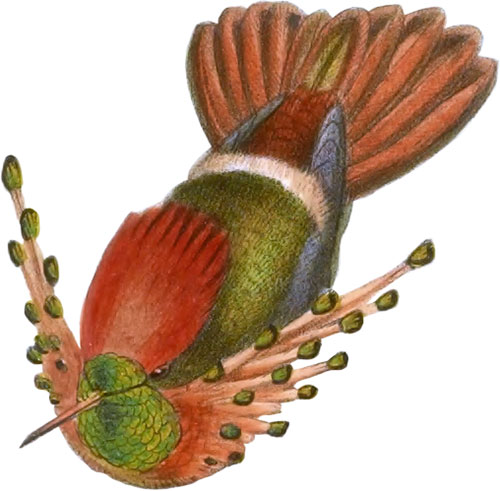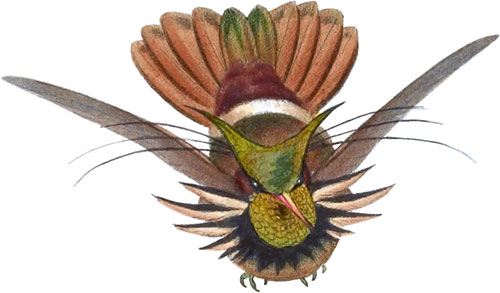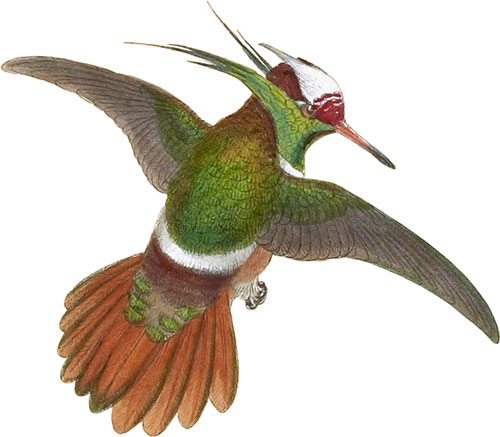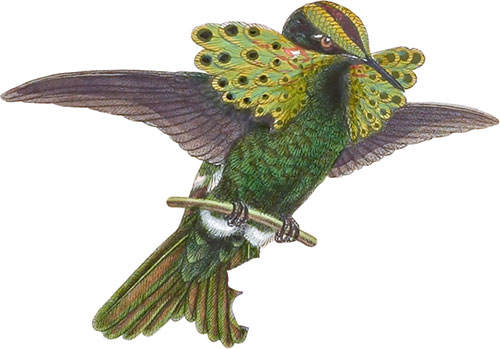Great-Crested Coquette
Cochabamba in Bolivia
For our knowledge of this fine species of Lophornis we are indebted to Mr. Bridges of Valparaiso, who found it at Moscosa, on the banks of the river Paracti near Espiritu Santo, and in the Yungas of Cochabamba in Bolivia.
It differs from all its congeners yet discovered in its larger size and more lengthened and fuller crest, the feathers of which are very pointed and surmounted by an extremely small dot of dark bronzy green. A smaller bird of this form received from Peru, although nearly allied to the one here represented, is, I believe, specifically different, as its crest is of a more truncate form, and has each feather terminated with a large spatule of dark bronze. I have also received several specimens which appear to me to belong to a third species; these, which were sent from Bogota, are of a still smaller size, and have the crest-feathers more filiform or hair-like, and scarcely a trace of spatule or spot on the tip. Time and future research are necessary to determine with certainty the specific value of the birds in question,—that is, if they be all varieties of one and the same bird, or if they constitute three distinct species: my own opinion inclines to the latter view, and I moreover believe that the great Andean range is not only the native country of three very distinct species of this beautiful form, but that it will be found to be the head-quarters of the genus, and that even more species may yet be expected from the temperate parts of that rich region.
A single example of a species of Lophornis, brought to Europe by M. De Lattre, was named after him by M. Lesson; I have not yet, however, been able to find the original specimen from which that naturalist took his description, consequently I have had no opportunity of instituting a comparison of his L. DeLattrei with the examples contained in my own collection, and I am therefore unable to say to which of the birds above mentioned it is referable. I have no doubt, however, of its being different from the bird here represented, which, so far as I am aware, is strictly confined to Bolivia.
The male has the crown of the head and crest bright rusty red, the feathers of the crest being much lengthened, carried to a point, and tipped with a minute spot of dark green; throat and breast luminous green, beneath which is a series of white lanceolate feathers; the slightly elongated feathers on the sides of the neck rufous, tipped with shining green; back and abdomen bronzy green; rump bronzy brown, crossed by a band of white; tail chestnut-brown, each feather margined externally with bronzy green; wings purplish brown; bill light brown, darker at the tip.
The female has the face and crown deep buff; throat whitish; upper and under surface, and wing-coverts bronzy; wings purplish brown; rump dark brown crossed by a band of white; tail bronzy green at the base, crossed by a broad dusky band, and the lateral feathers tipped with buff.
The Plate represents two males and a female of the natural size. The plant is the Gesneria elliptica.
 Lophornis ornatus
Tufted Coquette
Lophornis ornatus
Tufted Coquette
 Lophornis Gouldi
Gould’s Coquette
Lophornis Gouldi
Gould’s Coquette
 Lophornis magnificus
Frilled Coquette
Lophornis magnificus
Frilled Coquette
 Lophornis Delattrei
DeLattre’s Coquette
Lophornis Delattrei
DeLattre’s Coquette
 Lophornis Reginæ
Spangled Coquette
Lophornis Reginæ
Spangled Coquette
 Lophornis Helenæ
Princess Helena’s Coquette
Lophornis Helenæ
Princess Helena’s Coquette
 Lophornis adorabilis
Salvin’s Coquette
Lophornis adorabilis
Salvin’s Coquette
 Lophornis pavoninus
Roraima Coquette
Lophornis pavoninus
Roraima Coquette
Featuring all 422 illustrated species from John Gould’s A Monograph of the Trochilidæ, or Family of Humming-Birds arranged by color.